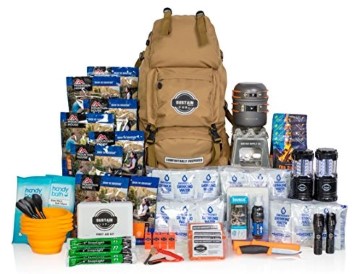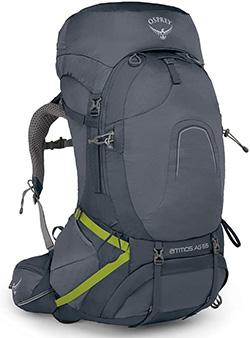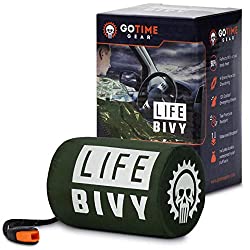As the American Red Cross emphasises, if disaster or crisis strikes your community, you might not have access to food, water, or electricity for some time. You may even need to get out of the area quickly. By taking time now to a build a bug out bag, you can provide for your entire family.
A bug out bag (BOB) or bug out kit or go bag or get home bag or disaster supplies kit is a collection of basic items that could be needed in the event of a disaster or crisis. You may wish to have several different types of kit in bags for different purposes, the information here is a general guide, customise it to your needs.
I will suggest things that you should include in your own bug out kit later in this article, but I found an excellent bug out bag and kit for a beginner. It is great if you want a premade, easy, quick, stress-less bug out bag solution and do not wish to find everything and pack it yourself . You can choose different options depending on your needs. It contains a lot of great stuff, all high-quality and well packed:

The above premade bug out bag is excellent, but I do always advise customising your survival kit to your own needs. It is more time and effort of course. If you wish to procure the survival items yourself, and customise your kit, we have the following lists which have been recommended by the American Red Cross and the CDC. It is important that if you do decide to collect the items yourself you store them appropriately and have proper bags for them in case you need to move.
Of Great Importance:
- Water—one gallon per person, per day
- Food—nonperishable, easy to prepare items
- Flashlight
- Battery powered or hand crank radio (NO AA Weather Radio, if possible)
- Extra batteries
- First aid kit
- Medications (7 day supply) and medical items
- Multipurpose tool
- Sanitation and personal hygiene items
- Copies of personal documents (medication list and pertinent medical information, proof of address, deed/lease to home, passports, birth certificates, insurance policies)
- Cell phone with chargers
- Family and emergency contact information
- Extra cash
- Emergency blanket
- Map(s) of the area
- Survival Knife (A good knife is essential and should be versatile, I recommend the Gerber LMF II Infantry Knife)
- Manual can opener
Consider the needs of all family members and add supplies to your bug out kit. Suggested items to help meet additional needs are:
- Baby supplies (bottles, formula, baby food, diapers)
- Games and activities for children
- Pet supplies (collar, leash, ID, food, carrier, bowl)
- Medical supplies (possibly including hearing aids with extra batteries, glasses, contact lenses, syringes, cane)
- Twoway radios
- Extra set of car keys and house keys
The following additional supplies, to keep at home or in your kit, based on the types of disasters common to your area, are suggested by the American Red Cross and the CDC. Perhaps they are of ‘lesser’ importance, but here at Bug Out Survival Kit we highly recommend obtaining many of them as well.
Of Lesser Importance (but still important!):
- Whistle
- N95 or surgical masks
- Water purification tablets or straws
- Matches
- Rain gear
- Towels
- Work gloves and/or disposable gloves
- Tools/supplies for securing your home etc
- Extra clothing, hat and sturdy shoes
- Plastic sheeting
- Duct tape
- Scissors
- Household liquid bleach
- Entertainment items
- Blankets or sleeping bags
The above lists are solid, essential guides, but your individual needs will vary somewhat of course. You will need something tough, light, and large enough to store most of the essentials that you assemble. If you are serious about bugging out you need a serious bug out bag. The Osprey has the best frame on the market, all the weight sits on your hips, you can hike for a day and not feel the weight on your shoulders. It is a reasonable price for such quality, and because of these factors we recommend this particular bug out bag as an important part of your bug out preperation:

A sleeping bag is of course for most situations advisable, and I found an interesting sleeping survival sleeping bag that doubles as an emergency sack to store your survival essentials! Also comes with a whistle, we have tried this thing out, and it is great considering the cheap price:

When you have assembled your survival kit items, pack them items in easy-to-carry containers, label the containers clearly and store them where they would be easily accessible. Duffle bags, backpacks (like the ones mentioned above), and covered trash receptacles are good candidates for containers. In a disaster situation, you may need access to your bug out kit quickly – whether you are sheltering at home or evacuating. Following a disaster or crisis, having the right supplies can help your household endure home confinement or evacuation. Make sure the needs of everyone who would use the survival kit are covered, including infants, seniors and pets.
The question is, if you do not already have a bug out bag, why not? If you are time poor, you can buy a premade bug out bag, if you are low on money, then you can slowly build you bug out kit bit by bit, starting with the essentials like food, water and a bag / backpack. It may just save you and your family one day.
There are many options to customise your bug out bag, think of the above guide as the essentials. Have a look at Unusual Survival Kit Items for many more bug out bag kit ideas.
